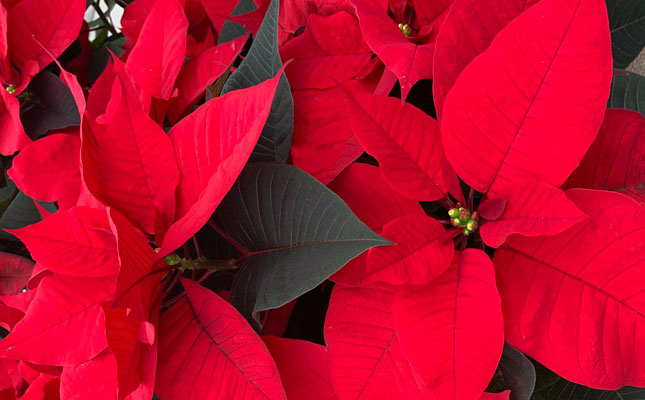
Whether you receive some plants this season as gifts or you purchase them to dress up your abode, now is the time to consider how to extend their life to maximize the pleasure that you get from them.
Poinsettia
The poinsettia is one of the few plants that will provide reliable colour through the winter. When you bring your poinsettia home, follow our five tips for poinsettia care:
1. Make your poinsettia pick-up the last on your shopping trip. They do not like a cold car (or anything cold).
2. For best performance indoors, place your poinsettia in a bright room or window: remember that they originated in the dessert and love sunshine.
3. Keep from drafts: opening doors and heating vents are the enemy.
4. Do not let it sit in water. If it is in a decorative sleeve or pot cover, either remove it or punch holes in the bottom for drainage.
5. Water ONLY when the soil is dry to the touch or, for larger plants, a centimetre below the surface. Fertilize only after the first month if you are not ready to compost it. Use a half strength 20-20-20 solution every 2 weeks.
Amaryllis
Amaryllis is a plant that gives you what you pay for it. There are specimens available for $10 or so and sometimes they are even gift boxed for that price! But they are small-ish bulbs that produce one or two stems of small-ish flowers.
The larger bulbs (28 to 32 cm circumference) are a much better value. They will produce up to 3 large stems and support up to 5 flowers per stem. More colour, more show, more fun.
To get your amaryllis off to the best start possible, be sure to plant it in sterile soil (not garden soil) and press the bulb into the soil firmly giving it a gentle turn. Leave about 1/3 of the bulb exposed, above the soil. If you plant the whole bulb, you risk the whole thing rotting before it has a chance to impress you with spectacular blossoms. Water it well and let the top centimetre or so of soil become dry between watering. Your amaryllis bulb arrives at your home in a dormant state. It will begin to grow when it is exposed to sunshine and temperatures in the range of 18 to 22oC.
As the first flower stem grows be sure to turn your plant away from the sun every second day otherwise it will tilt in the direction of the window and eventually fall over.
When the first stem begins to bloom pull the plant back into the room where there is less direct sunlight. This will have the effect of slowing down the blooming process and prolonging it, providing the maximum amount of time for you to enjoy it. The second and third flower stem usually arrive in the lower light situation, but if yours is stubborn, put it back in a high-light window and wait for the new flower stems to arrive.
Mid to late winter your amaryllis will have exhausted itself and finished flowering. Now it needs a rest, which consists of producing a lot of leaves that need the direct exposure to the sun, once again. The leaves are the food-factory of the bulb. They will convert the energy of the sun into nutrition that will be transported to the bulb to help beef it up for a reflowering period next season.
Cyclamen
Mark’s favourite seasonal indoor plant is the Cyclamen. Many of the new introductions over recent years have featured wonderful colour combinations and the solid-coloured plants are available in vivid shades of red, pink and white that will knock your eyes out.
You do not need a green thumb to take care of cyclamen. Water this plant when the soil feels dry. Gradually cut back on watering as the flowers fade and the plant goes dormant in the spring.
While in bloom, place it in a bright window. While dormant, keep it in a cool dark place with good air circulation. Avoid getting the soil wet while the plant is dormant as the root tuber can rot. Cyclamen will emerge from dormancy in September. Start watering and fertilizing regularly at this point. Move the plant to a bright room but keep it away from direct sunlight until it blooms.
Cyclamen need relatively high humidity especially during the dry winter months. Mist it with water every day or two and keep in the coolest room in your house for best performance. Doing this will ensure it survives and blooms next winter.
For more advice and answers to over 10,000 gardening questions sign up for Mark and Ben’s free monthly newsletter.

